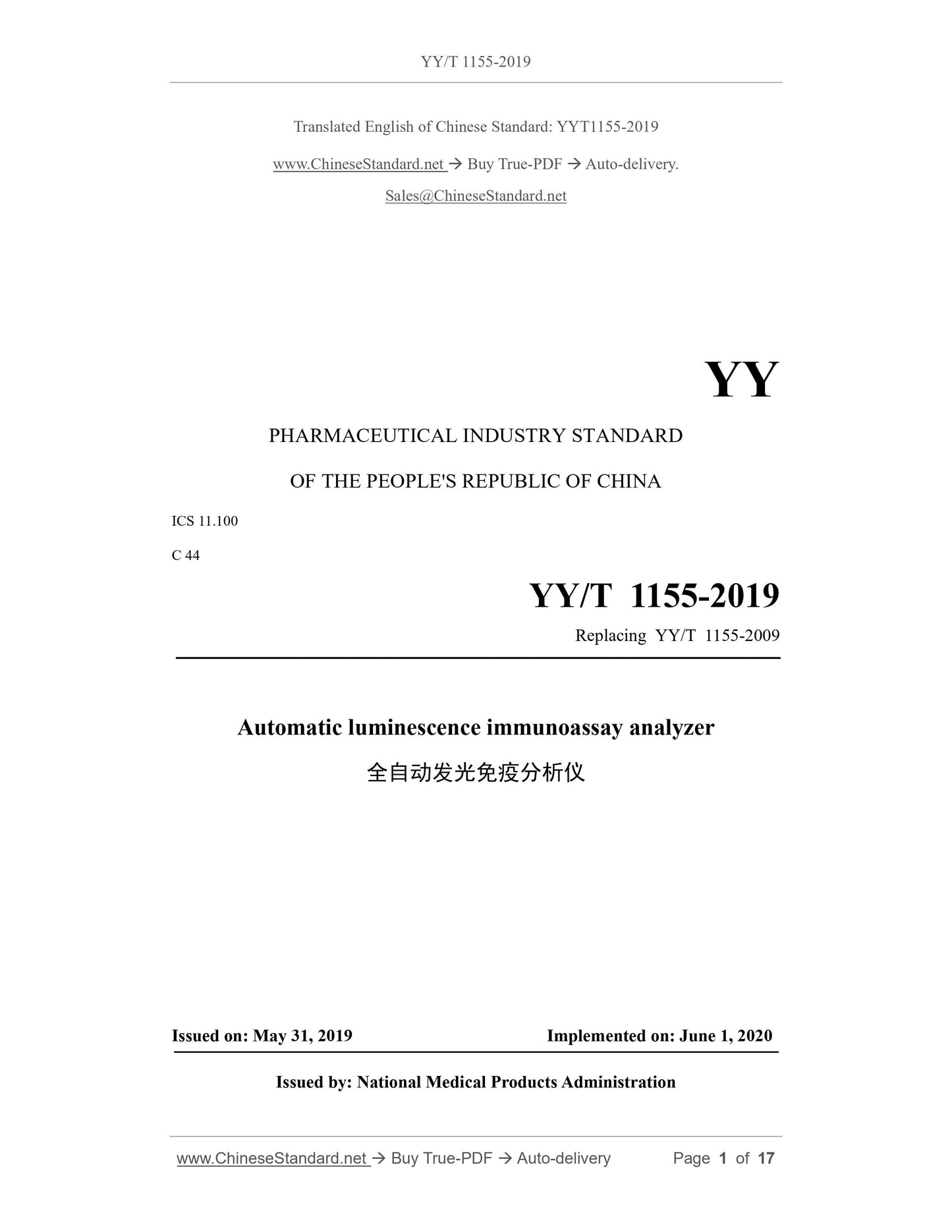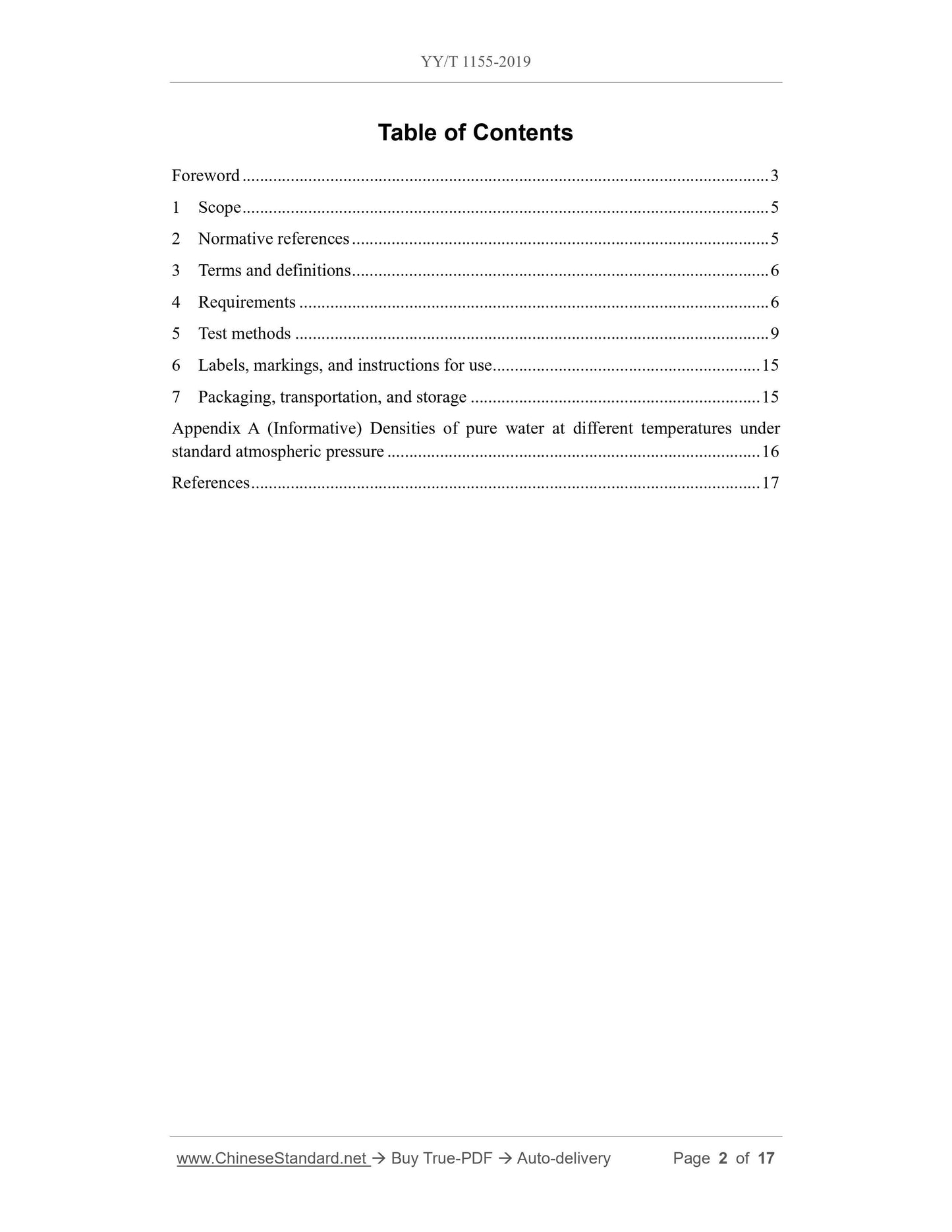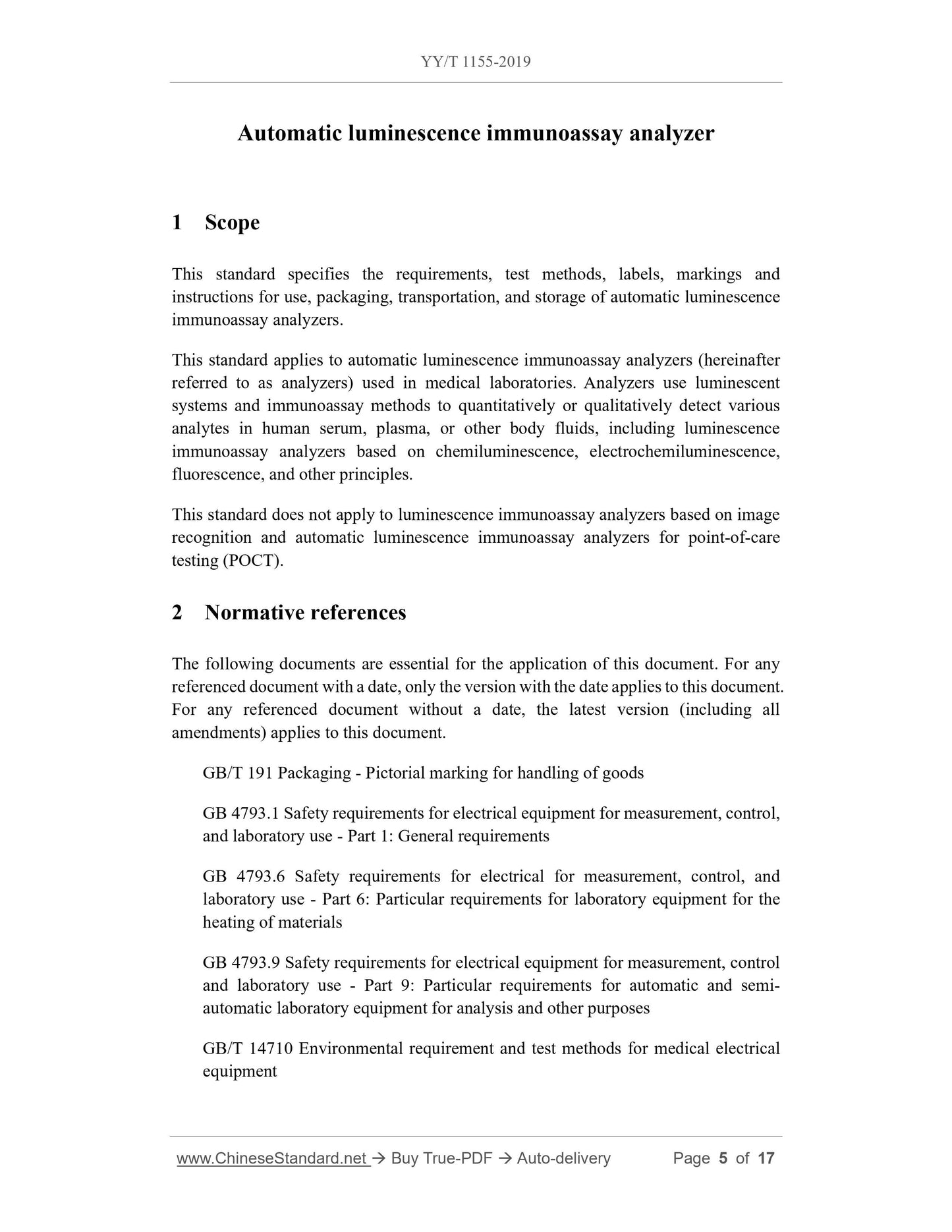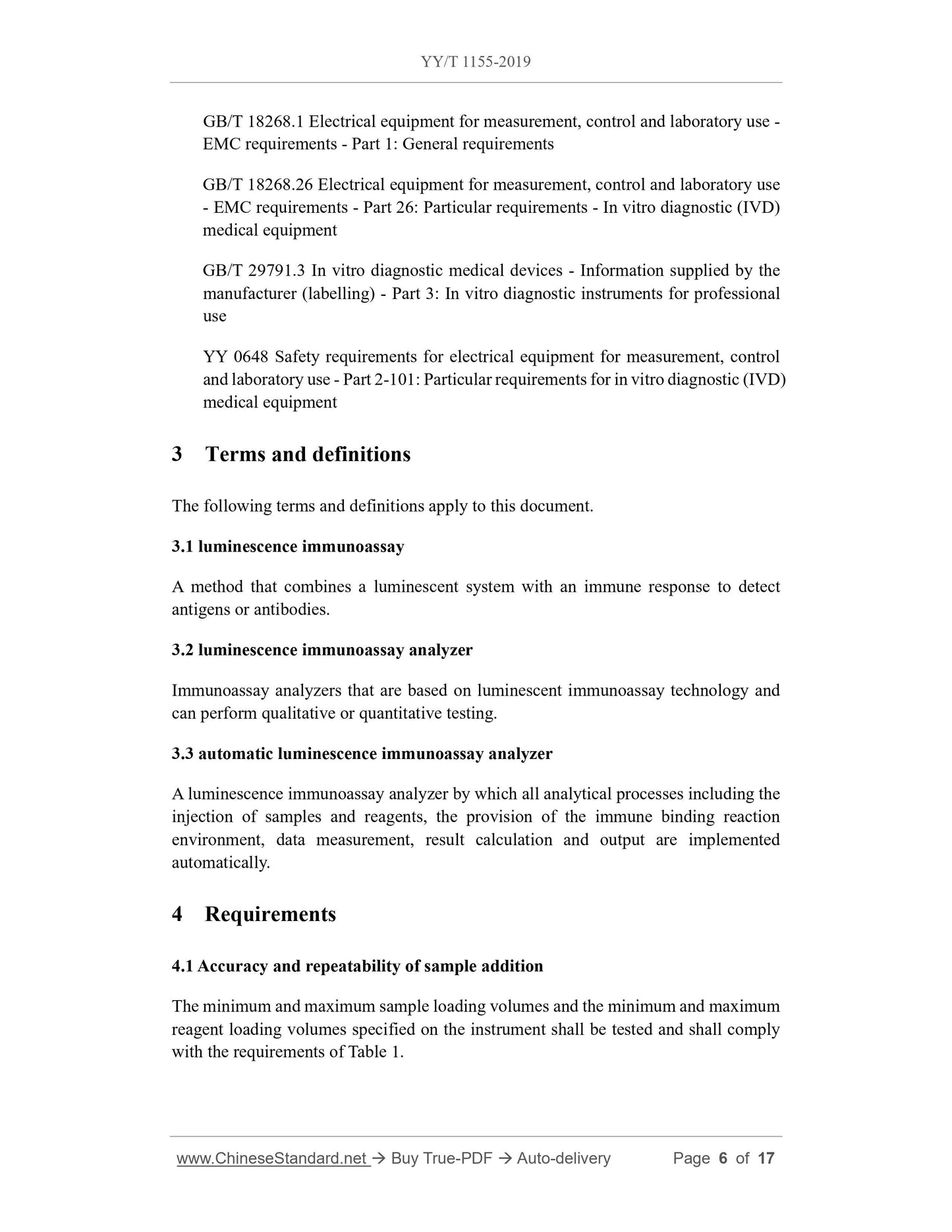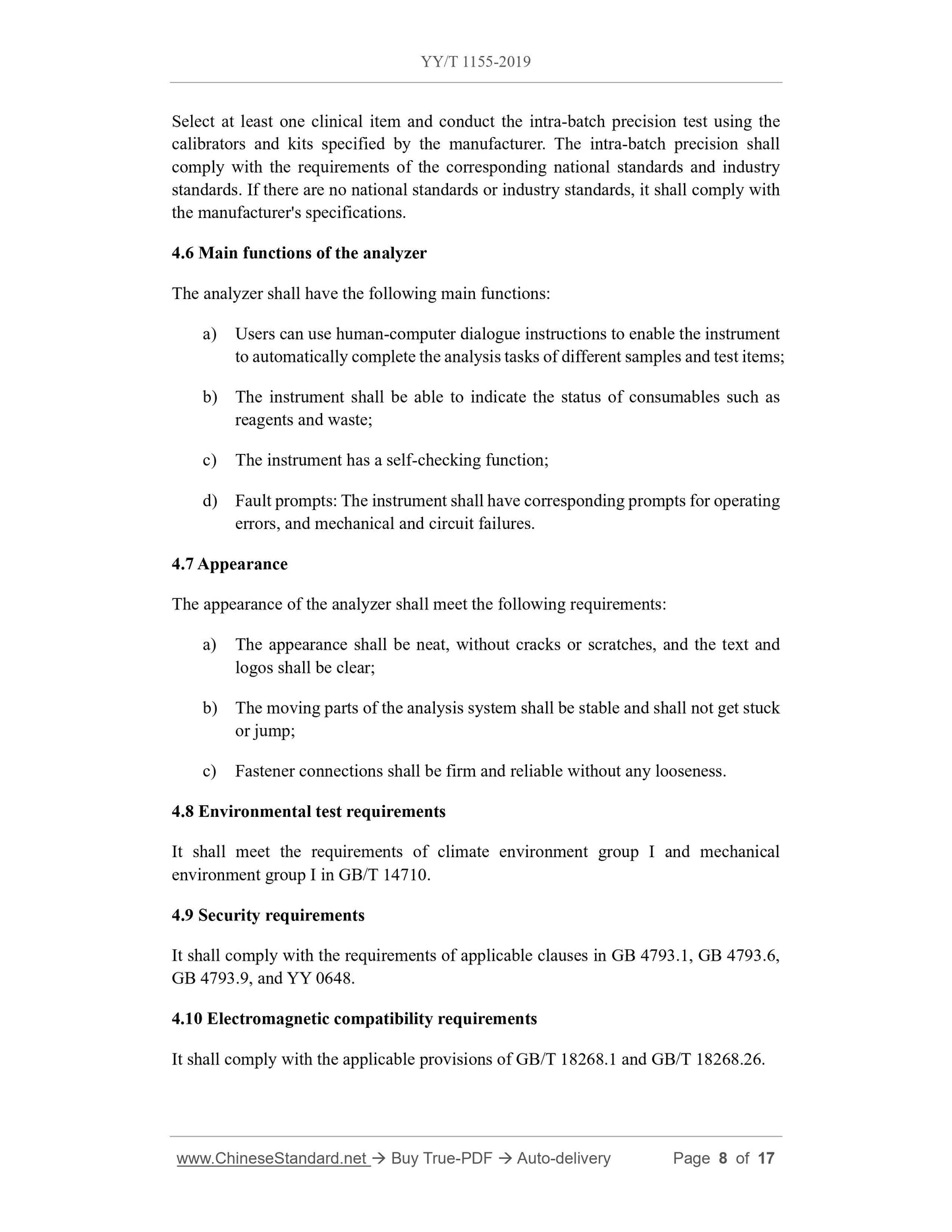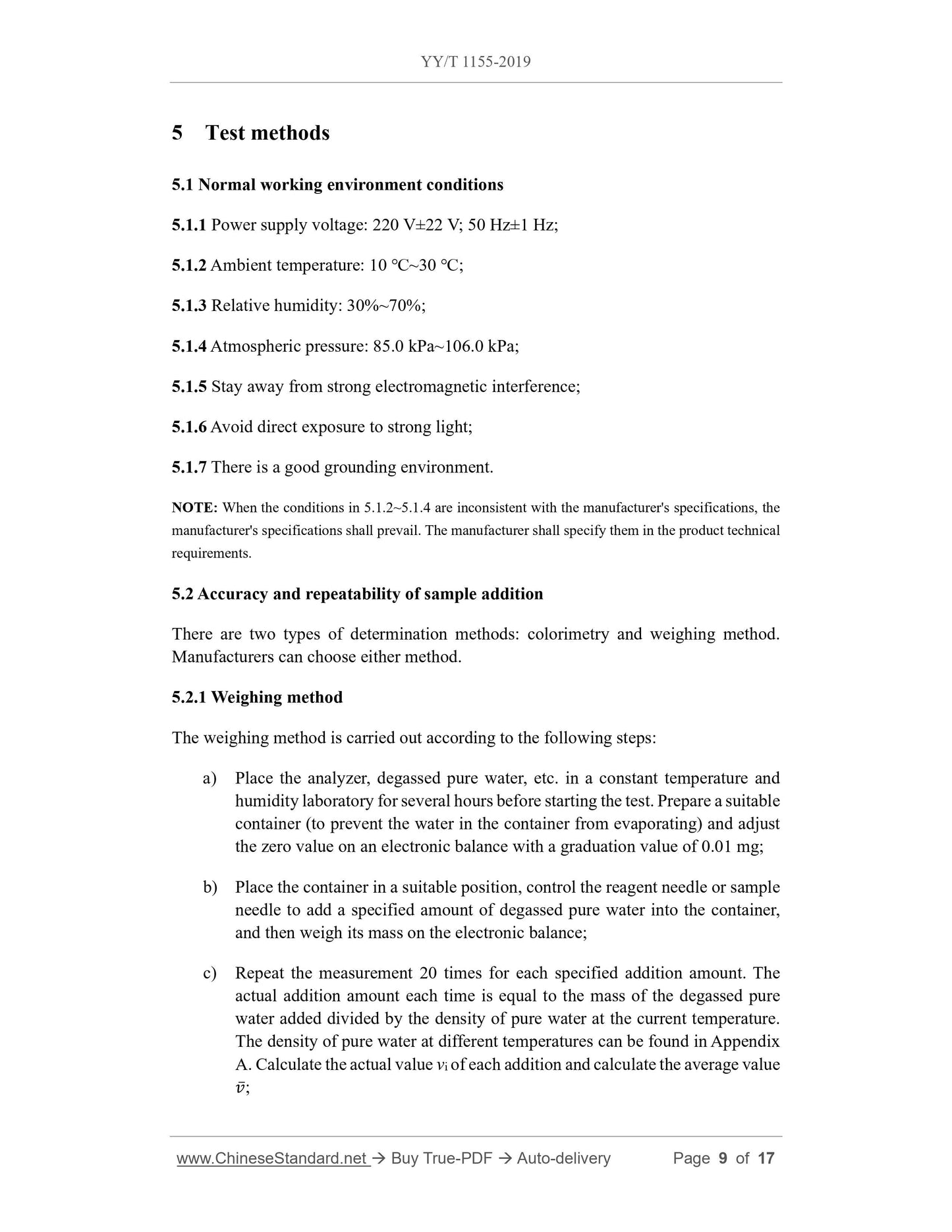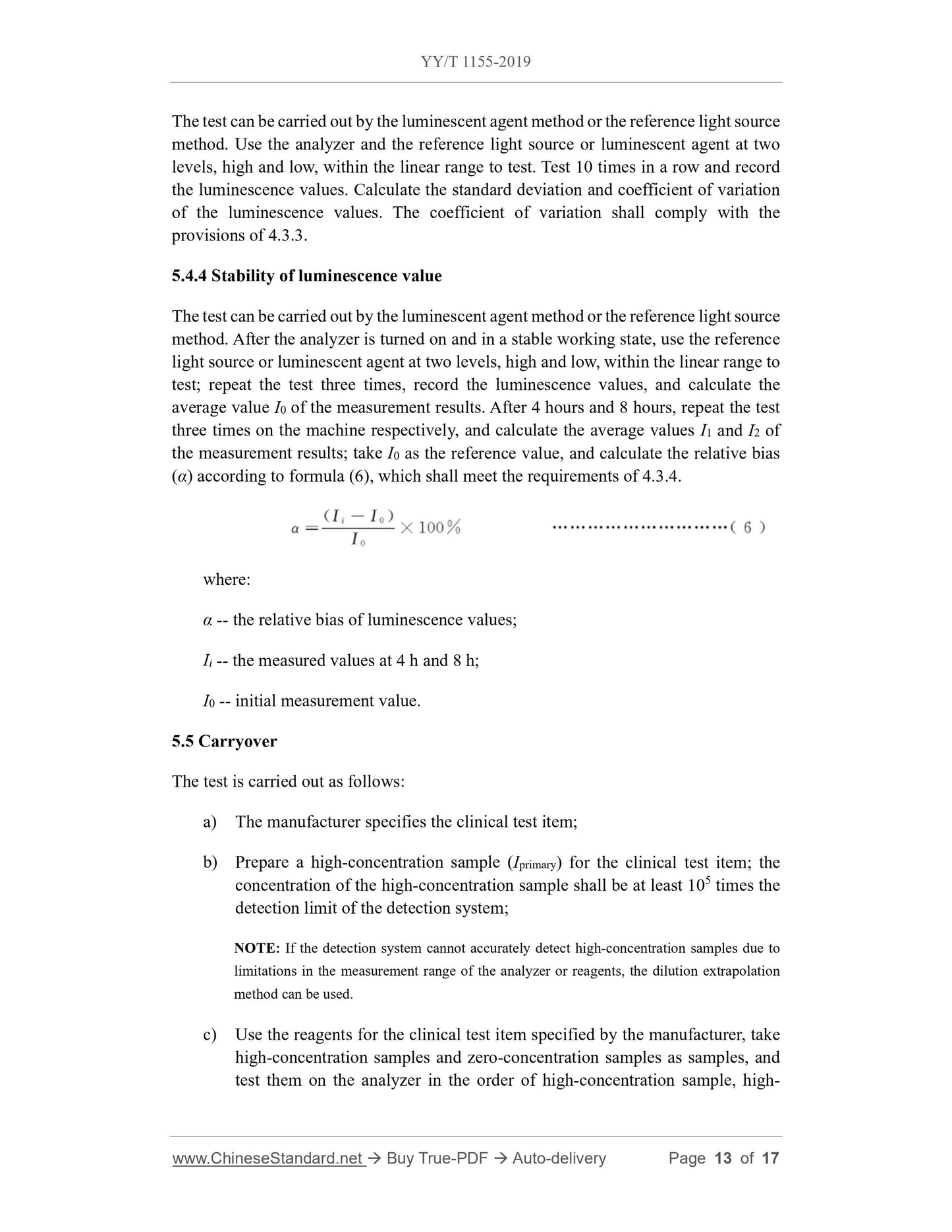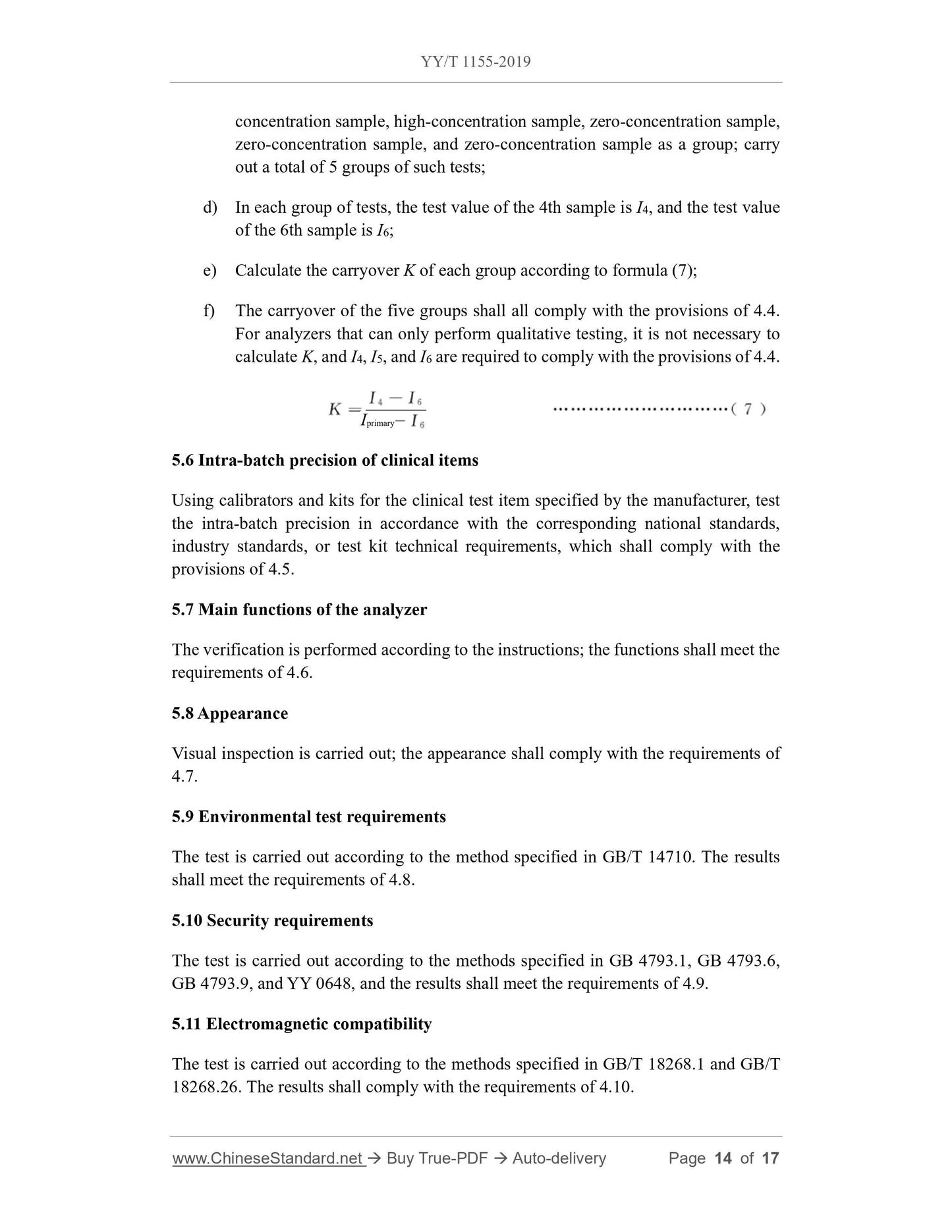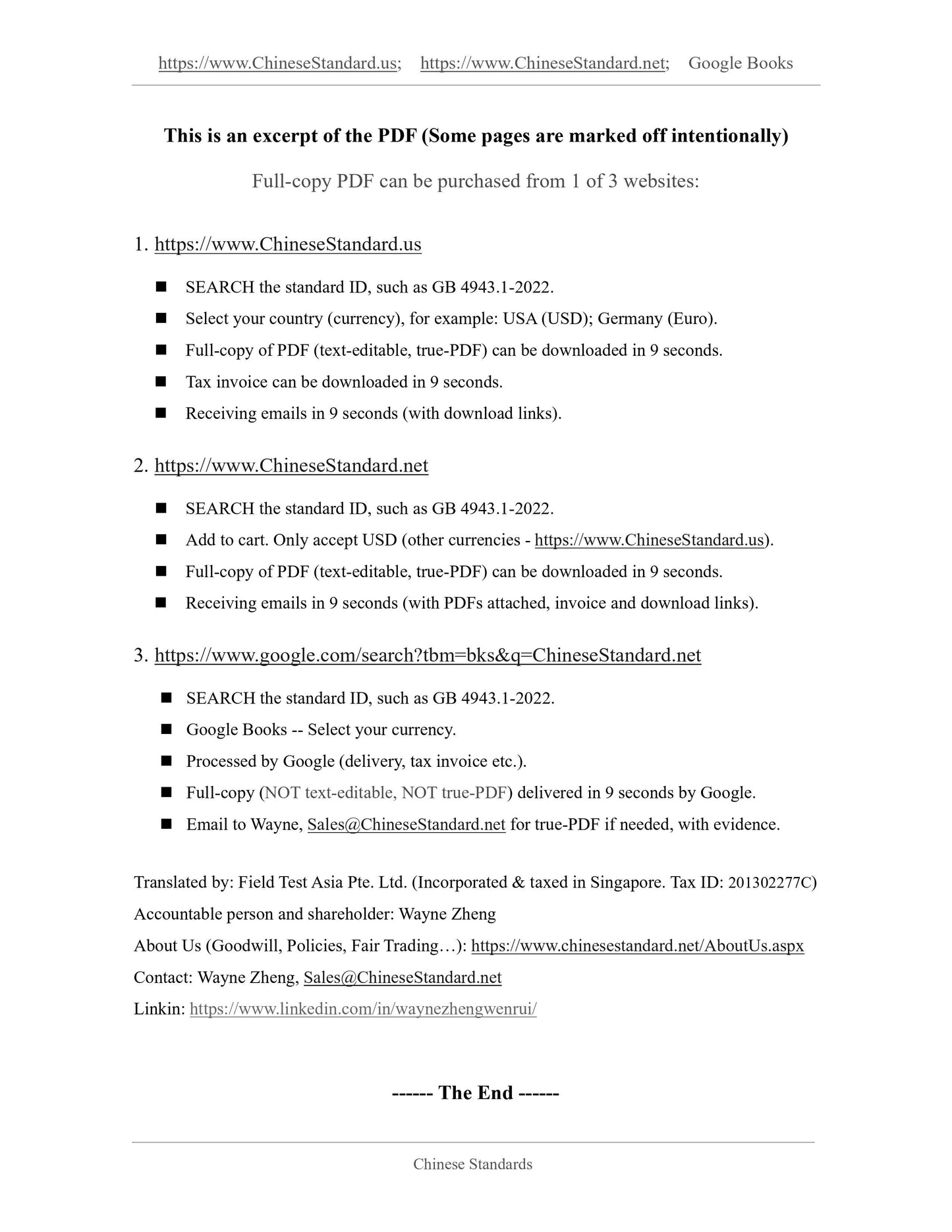1
/
of
9
PayPal, credit cards. Download editable-PDF and invoice in 1 second!
YY/T 1155-2019 English PDF (YYT1155-2019)
YY/T 1155-2019 English PDF (YYT1155-2019)
Regular price
$245.00 USD
Regular price
Sale price
$245.00 USD
Unit price
/
per
Shipping calculated at checkout.
Couldn't load pickup availability
Delivery: 3 seconds. Download true-PDF + Invoice.
Get QUOTATION in 1-minute: Click YY/T 1155-2019
Historical versions: YY/T 1155-2019
Preview True-PDF (Reload/Scroll if blank)
YY/T 1155-2019: Automatic luminescence immunoassay analyzer
YY/T 1155-2019
YY
PHARMACEUTICAL INDUSTRY STANDARD
OF THE PEOPLE'S REPUBLIC OF CHINA
ICS 11.100
C 44
Replacing YY/T 1155-2009
Automatic luminescence immunoassay analyzer
ISSUED ON: MAY 31, 2019
IMPLEMENTED ON: JUNE 1, 2020
Issued by: National Medical Products Administration
Table of Contents
Foreword ... 3
1 Scope ... 5
2 Normative references ... 5
3 Terms and definitions ... 6
4 Requirements ... 6
5 Test methods ... 9
6 Labels, markings, and instructions for use ... 15
7 Packaging, transportation, and storage ... 15
Appendix A (Informative) Densities of pure water at different temperatures under
standard atmospheric pressure ... 16
References ... 17
Automatic luminescence immunoassay analyzer
1 Scope
This standard specifies the requirements, test methods, labels, markings and
instructions for use, packaging, transportation, and storage of automatic luminescence
immunoassay analyzers.
This standard applies to automatic luminescence immunoassay analyzers (hereinafter
referred to as analyzers) used in medical laboratories. Analyzers use luminescent
systems and immunoassay methods to quantitatively or qualitatively detect various
analytes in human serum, plasma, or other body fluids, including luminescence
immunoassay analyzers based on chemiluminescence, electrochemiluminescence,
fluorescence, and other principles.
This standard does not apply to luminescence immunoassay analyzers based on image
recognition and automatic luminescence immunoassay analyzers for point-of-care
testing (POCT).
2 Normative references
The following documents are essential for the application of this document. For any
referenced document with a date, only the version with the date applies to this document.
For any referenced document without a date, the latest version (including all
amendments) applies to this document.
GB/T 191 Packaging - Pictorial marking for handling of goods
GB 4793.1 Safety requirements for electrical equipment for measurement, control,
and laboratory use - Part 1: General requirements
GB 4793.6 Safety requirements for electrical for measurement, control, and
laboratory use - Part 6: Particular requirements for laboratory equipment for the
heating of materials
GB 4793.9 Safety requirements for electrical equipment for measurement, control
and laboratory use - Part 9: Particular requirements for automatic and semi-
automatic laboratory equipment for analysis and other purposes
GB/T 14710 Environmental requirement and test methods for medical electrical
equipment
GB/T 18268.1 Electrical equipment for measurement, control and laboratory use -
EMC requirements - Part 1: General requirements
GB/T 18268.26 Electrical equipment for measurement, control and laboratory use
- EMC requirements - Part 26: Particular requirements - In vitro diagnostic (IVD)
medical equipment
GB/T 29791.3 In vitro diagnostic medical devices - Information supplied by the
manufacturer (labelling) - Part 3: In vitro diagnostic instruments for professional
use
YY 0648 Safety requirements for electrical equipment for measurement, control
and laboratory use - Part 2-101: Particular requirements for in vitro diagnostic (IVD)
medical equipment
3 Terms and definitions
The following terms and definitions apply to this document.
3.1 luminescence immunoassay
A method that combines a luminescent system with an immune response to detect
antigens or antibodies.
3.2 luminescence immunoassay analyzer
Immunoassay analyzers that are based on luminescent immunoassay technology and
can perform qualitative or quantitative testing.
3.3 automatic luminescence immunoassay analyzer
A luminescence immunoassay analyzer by which all analytical processes including the
injection of samples and reagents, the provision of the immune binding reaction
environment, data measurement, result calculation and output are implemented
automatically.
4 Requirements
4.1 Accuracy and repeatability of sample addition
The minimum and maximum sample loading volumes and the minimum and maximum
reagent loading volumes specified on the instrument shall be tested and shall comply
with the requirements of Table 1.
Select at least one clinical item and conduct the intra-batch precision test using the
calibrators and kits specified by the manufacturer. The intra-batch precision shall
comply with the requirements of the corresponding national standards and industry
standards. If there are no national standards or industry standards, it shall comply with
the manufacturer's specifications.
4.6 Main functions of the analyzer
The analyzer shall have the following main functions:
a) Users can use human-computer dialogue instructions to enable the instrument
to automatically complete the analysis tasks of different samples and test items;
b) The instrument shall be able to indicate the status of consumables such as
reagents and waste;
c) The instrument has a self-checking function;
d) Fault prompts: The instrument shall have corresponding prompts for operating
errors, and mechanical and circuit failures.
4.7 Appearance
The appearance of the analyzer shall meet the following requirements:
a) The appearance shall be neat, without cracks or scratches, and the text and
logos shall be clear;
b) The moving parts of the analysis system shall be stable and shall not get stuck
or jump;
c) Fastener connections shall be firm and reliable without any looseness.
4.8 Environmental test requirements
It shall meet the requirements of climate environment group I and mechanical
environment group I in GB/T 14710.
4.9 Security requirements
It shall comply with the requirements of applicable clauses in GB 4793.1, GB 4793.6,
GB 4793.9, and YY 0648.
4.10 Electromagnetic compatibility requirements
It shall comply with the applicable provisions of GB/T 18268.1 and GB/T 18268.26.
5 Test methods
5.1 Normal working environment conditions
5.1.1 Power supply voltage: 220 V±22 V; 50 Hz±1 Hz;
5.1.2 Ambient temperature: 10 ℃~30 ℃;
5.1.3 Relative humidity: 30%~70%;
5.1.4 Atmospheric pressure: 85.0 kPa~106.0 kPa;
5.1.5 Stay away from strong electromagnetic interference;
5.1.6 Avoid direct exposure to strong light;
5.1.7 There is a good grounding environment.
NOTE: When the conditions in 5.1.2~5.1.4 are inconsistent with the manufacturer's specifications, the
manufacturer's specifications shall prevail. The manufacturer shall specify them in the product technical
requirements.
5.2 Accuracy and repeatability of sample addition
There are two types of determination methods: colorimetry and weighing method.
Manufacturers can choose either method.
5.2.1 Weighing method
The weighing method is carried out according to the following steps:
a) Place the analyzer, degassed pure water, etc. in a constant temperature and
humidity laboratory for several hours before starting the test. Prepare a suitable
container (to prevent the water in the container from evaporating) and adjust
the zero value on an electronic balance with a graduation value of 0.01 mg;
b) Place the container in a suitable position, control the reagent needle or sample
needle to add a specified amount of degassed pure water into the container,
and then weigh its mass on the electronic balance;
c) Repeat the measurement 20 times for each specified addition amount. The
actual addition amount each time is equal to the mass of the degassed pure
water added ...
Get QUOTATION in 1-minute: Click YY/T 1155-2019
Historical versions: YY/T 1155-2019
Preview True-PDF (Reload/Scroll if blank)
YY/T 1155-2019: Automatic luminescence immunoassay analyzer
YY/T 1155-2019
YY
PHARMACEUTICAL INDUSTRY STANDARD
OF THE PEOPLE'S REPUBLIC OF CHINA
ICS 11.100
C 44
Replacing YY/T 1155-2009
Automatic luminescence immunoassay analyzer
ISSUED ON: MAY 31, 2019
IMPLEMENTED ON: JUNE 1, 2020
Issued by: National Medical Products Administration
Table of Contents
Foreword ... 3
1 Scope ... 5
2 Normative references ... 5
3 Terms and definitions ... 6
4 Requirements ... 6
5 Test methods ... 9
6 Labels, markings, and instructions for use ... 15
7 Packaging, transportation, and storage ... 15
Appendix A (Informative) Densities of pure water at different temperatures under
standard atmospheric pressure ... 16
References ... 17
Automatic luminescence immunoassay analyzer
1 Scope
This standard specifies the requirements, test methods, labels, markings and
instructions for use, packaging, transportation, and storage of automatic luminescence
immunoassay analyzers.
This standard applies to automatic luminescence immunoassay analyzers (hereinafter
referred to as analyzers) used in medical laboratories. Analyzers use luminescent
systems and immunoassay methods to quantitatively or qualitatively detect various
analytes in human serum, plasma, or other body fluids, including luminescence
immunoassay analyzers based on chemiluminescence, electrochemiluminescence,
fluorescence, and other principles.
This standard does not apply to luminescence immunoassay analyzers based on image
recognition and automatic luminescence immunoassay analyzers for point-of-care
testing (POCT).
2 Normative references
The following documents are essential for the application of this document. For any
referenced document with a date, only the version with the date applies to this document.
For any referenced document without a date, the latest version (including all
amendments) applies to this document.
GB/T 191 Packaging - Pictorial marking for handling of goods
GB 4793.1 Safety requirements for electrical equipment for measurement, control,
and laboratory use - Part 1: General requirements
GB 4793.6 Safety requirements for electrical for measurement, control, and
laboratory use - Part 6: Particular requirements for laboratory equipment for the
heating of materials
GB 4793.9 Safety requirements for electrical equipment for measurement, control
and laboratory use - Part 9: Particular requirements for automatic and semi-
automatic laboratory equipment for analysis and other purposes
GB/T 14710 Environmental requirement and test methods for medical electrical
equipment
GB/T 18268.1 Electrical equipment for measurement, control and laboratory use -
EMC requirements - Part 1: General requirements
GB/T 18268.26 Electrical equipment for measurement, control and laboratory use
- EMC requirements - Part 26: Particular requirements - In vitro diagnostic (IVD)
medical equipment
GB/T 29791.3 In vitro diagnostic medical devices - Information supplied by the
manufacturer (labelling) - Part 3: In vitro diagnostic instruments for professional
use
YY 0648 Safety requirements for electrical equipment for measurement, control
and laboratory use - Part 2-101: Particular requirements for in vitro diagnostic (IVD)
medical equipment
3 Terms and definitions
The following terms and definitions apply to this document.
3.1 luminescence immunoassay
A method that combines a luminescent system with an immune response to detect
antigens or antibodies.
3.2 luminescence immunoassay analyzer
Immunoassay analyzers that are based on luminescent immunoassay technology and
can perform qualitative or quantitative testing.
3.3 automatic luminescence immunoassay analyzer
A luminescence immunoassay analyzer by which all analytical processes including the
injection of samples and reagents, the provision of the immune binding reaction
environment, data measurement, result calculation and output are implemented
automatically.
4 Requirements
4.1 Accuracy and repeatability of sample addition
The minimum and maximum sample loading volumes and the minimum and maximum
reagent loading volumes specified on the instrument shall be tested and shall comply
with the requirements of Table 1.
Select at least one clinical item and conduct the intra-batch precision test using the
calibrators and kits specified by the manufacturer. The intra-batch precision shall
comply with the requirements of the corresponding national standards and industry
standards. If there are no national standards or industry standards, it shall comply with
the manufacturer's specifications.
4.6 Main functions of the analyzer
The analyzer shall have the following main functions:
a) Users can use human-computer dialogue instructions to enable the instrument
to automatically complete the analysis tasks of different samples and test items;
b) The instrument shall be able to indicate the status of consumables such as
reagents and waste;
c) The instrument has a self-checking function;
d) Fault prompts: The instrument shall have corresponding prompts for operating
errors, and mechanical and circuit failures.
4.7 Appearance
The appearance of the analyzer shall meet the following requirements:
a) The appearance shall be neat, without cracks or scratches, and the text and
logos shall be clear;
b) The moving parts of the analysis system shall be stable and shall not get stuck
or jump;
c) Fastener connections shall be firm and reliable without any looseness.
4.8 Environmental test requirements
It shall meet the requirements of climate environment group I and mechanical
environment group I in GB/T 14710.
4.9 Security requirements
It shall comply with the requirements of applicable clauses in GB 4793.1, GB 4793.6,
GB 4793.9, and YY 0648.
4.10 Electromagnetic compatibility requirements
It shall comply with the applicable provisions of GB/T 18268.1 and GB/T 18268.26.
5 Test methods
5.1 Normal working environment conditions
5.1.1 Power supply voltage: 220 V±22 V; 50 Hz±1 Hz;
5.1.2 Ambient temperature: 10 ℃~30 ℃;
5.1.3 Relative humidity: 30%~70%;
5.1.4 Atmospheric pressure: 85.0 kPa~106.0 kPa;
5.1.5 Stay away from strong electromagnetic interference;
5.1.6 Avoid direct exposure to strong light;
5.1.7 There is a good grounding environment.
NOTE: When the conditions in 5.1.2~5.1.4 are inconsistent with the manufacturer's specifications, the
manufacturer's specifications shall prevail. The manufacturer shall specify them in the product technical
requirements.
5.2 Accuracy and repeatability of sample addition
There are two types of determination methods: colorimetry and weighing method.
Manufacturers can choose either method.
5.2.1 Weighing method
The weighing method is carried out according to the following steps:
a) Place the analyzer, degassed pure water, etc. in a constant temperature and
humidity laboratory for several hours before starting the test. Prepare a suitable
container (to prevent the water in the container from evaporating) and adjust
the zero value on an electronic balance with a graduation value of 0.01 mg;
b) Place the container in a suitable position, control the reagent needle or sample
needle to add a specified amount of degassed pure water into the container,
and then weigh its mass on the electronic balance;
c) Repeat the measurement 20 times for each specified addition amount. The
actual addition amount each time is equal to the mass of the degassed pure
water added ...
Share
